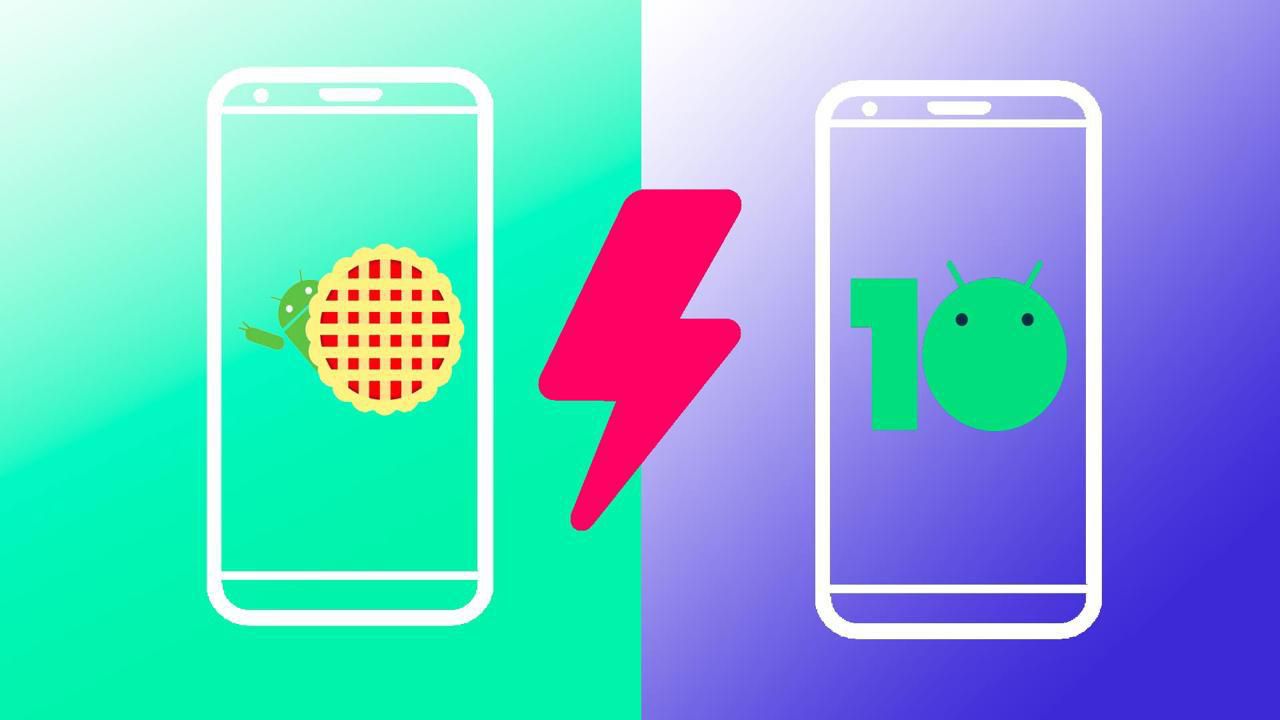Google brought in a revolution in the year 2009 which has been continuing ever since. This article consists of one of the major discussion of debate about Android 10 vs Android 9. Every year, a new look is introduced to all our Android devices and we cannot be more excited about it. Android 10, formerly known as Android Q until Google decided to finally ditch dessert names, is the latest operating system from Google, and since the majority of the world uses Android, you can expect your phone will likely run it soon.
The Android 10 update brings a ton of new features. Among all the new toys, the long-awaited system-wide dark mode (called ‘Dark Theme‘) is the biggest shift from Android Pie. iOS-like Gesture Navigation has also been added, along with privacy controls and Focus Mode for shutting notifications off when you need to get things done.
One major question now going around is android 10 vs android 9: Which one is better? So, going with the same flow, let’s compare the two recent Android OS versions today!
Android 10 vs Android 9 Ultimate Showdown
1. The Looks That Matters
Every one loves their smartphone and now a days how your smartphone looks has somewhat became a style element. Google also know this fact hence they try to improve something or everything with every android update that they produce and Android 10 is no different.
The latest version of android is focused to give users full control over their looks of their device. The thing that make Android 10 standout over Android Pie is optimized dark mode and power to change themes and fonts along with that you also get an option to change the shape of the icons as well that makes you customize your device that suites your personality.
2. Smart Replay And Emojis
The comparison between two titans i.e. android 10 vs. android 9 can’t be completed without taking in consideration a very special feature that has been added in android 10 that is titled as ‘Smart Replay’ it comes handy whenever you are in a hurry and can’t replay to incoming messages with full authority. It uses a very sophisticated algorithm to suggest some action that you may find useful in context with received message.
For instance in the above image you can see that we received a text from John stating us to meet him at some location and with help of smart replay we get some options that are useful in the context of the text it shows a thumbs up emoji an option to replay as ‘No, I Can’t’ and the most useful one is the option to open google maps to see the location of the place stated in the text.
3. Battery Consumption and Optimization
Over the last few Android updates, Google has tried to make the system use less battery, particularly when the phone snoozing in your pocket. No doubt, Android 9.0 Pie improved battery levels by introducing ‘Adaptive Battery’ and ‘Automatic Brightness Adjust’ functionality. Android Pie makes the control of background power use more visible, with a mode called
Apps you use rarely will only have the most basic of background permissions. Any notifications from them may be delayed, but they’ll use less battery as a result. Apps you use all the time won’t be affected. But, with the dark mode and an upgraded adaptive battery setting, Android 10’s battery life is found to be longer than that of its predecessor.
4. Gesture Navigation Controls

As this decade has been dedicated to larger screen size and more screen space every smartphone manufacture has tried there best to give peoples what they want by using different approaches like increasing the screen size, changing the aspect ratio of the device and by taking help of software. Android 9 showed the world that how can a pill shape home button ease up there urge to have more screen space. Android 9 gave us the pill navigation gesture which can be applied to work in a multi dimensional format as you can single tap the pill to go to home screen, swipe while holding the pill to see recent apps.
Android 10 is here to change the game with its super-smooth and top notch gesture navigation. It utilizes no screen space at all, You just have to swipe up from the middle of your screen to go to your home-screen while a swipe and hold from the center of the screen will take you in the recent app menu and to go back to the previous menu you can swipe from either side of the screen i.e. swipe from left to right of the screen or swipe right to left from the screen as well.
5. Bluetooth, Wi-Fi, and Other Connectivity Options
When looking into Android 10 vs Android 9 OS version war in terms of connectivity, both the versions have proven to be ultimate. Android 9, on one side, brought the functionality of connecting with 5 different devices and switch between them in real-time. While with Android 10 you can share your WiFi with others without telling them the password.
All you have to do is just open your WiFi settings and click on the network that you are connected to and you will find two options i.e. ‘Forget’ and ‘Share’ and as you click the share option a QR code will be displayed on your screen and the other person just have to scan that code using their smartphones camera and they will be connected to that network instantly. Android 10 has also introduced a special WiFi feature that is titled as ‘Adaptive WiFi’ which which provide you with seamless connectivity while playing an online game.
6. Fast Share
One feature Android 10 doesn’t have is Android Beam, the NFC peer-to-peer sharing method when two devices are nearby. Android 10 has replaced Android Beam with Fast Share. The Fast Share now employs the combination of Bluetooth and Wi-Fi Direct to create a connection and transfer files faster than what was possible in Android 9.0 Pie.
7. Notifications
In Android 9, when you pull down the bar and check incoming messages and such. Both on the lock screen, or in general, all notifications have rounded edges. In Android Pie, notifications were smarter, more powerful, bundled together, and the “reply” feature inside the notification bar is better than ever. With Android 9 you can see images, stickers, and media in the notification bar before you open a message. We get big helpful previews. The in-line reply is smarter and easier to use, too. These are subtle yet welcomed changes.
App notifications now appear in the form of bubble chat heads. These circular notifications floating across the screen enables users to perform some other task while attending these notifications, just like what we do when using Facebook Messenger. One can set notifications to Silent or on Alerting mode, depending on their urgency.
8. Digital WellBeing
Digital WellBeing, one of the top Android Pie features that let users know which apps they are spending most of their time and thus, look ahead to curb phone addiction has also received an upgrade in Android 10. Digital Wellbeing gives you a range of ways to manage your screen time in a healthy way. The new Android version has come up with a new option called ‘Focus Mode’ . Focus mode is focused to turn off app notifications for some particular apps that may distract you while working. You can set the focus mode to automatically turn on for on specific time frame of the day as per your working schedule.
Then there’s Family Link, so you can monitor how much time your dependents are spending on games or other apps, and how long they’re spending on their phone in general.
9. Privacy and Security

As you open the privacy menu it will reveal the various permissions apps can request for things like calendar, location, camera, contacts, and microphone. In comparison to its predecessor, Android 10 has come up with different privacy and security updates like – Users now have better options in terms of location-access permission. They can decide if they want to make their location accessible to third parties only when they are using, or all the time.
Android 10 Privacy
With Android 10, there’s now a dedicated Privacy section in the settings app. Opening it will reveal the various permissions apps can request for things like calendar, location, camera, contacts, and microphone. Android mobile apps operating in the background would have to seek permission to access data. Access to Wi-Fi, Bluetooth, and other connectivity options won’t be possible without users’ permission. Significant changes have been made to Biometric API to enable applications to employ the functionality of fingerprint and facial authentication in a far robust and secure manner.
Final Verdict: Android 10 vs Android 9
So, on a whole, there are various differences between Android 10 and 9, such as – Advent of Dark Mode in Android 10. Android Beam is not available in Android 10. Unlike Android 9, its successor has come up with support for 5G network and Foldable devices. Android 10 offers a smart reply and suggestions in almost all the apps. Android 10 has also brought the feature of Live Caption in the space. With this feature, users will be able to access automatic captions for all the media files, including videos, audio messages, and podcasts. And the best part is that this feature is available in offline mode too.



















